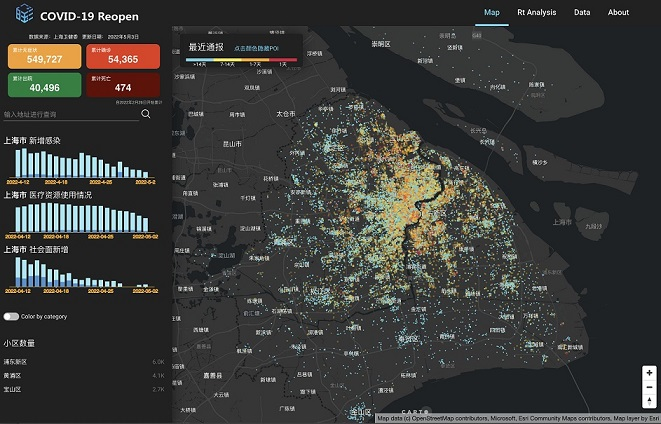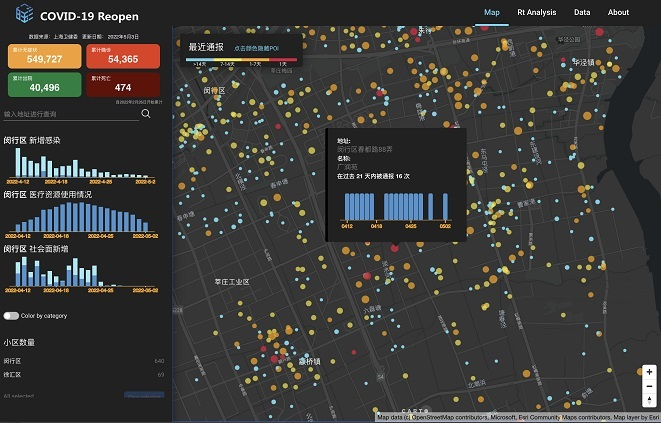Prof Jin Yaohui's Team Develops "Shanghai COVID-19 ReOpen", an Open-Source Visualization Platform for Shanghai Epidemic
Date:2022-05-23 Source: SJTU ENGLISH WEBSITE Reading: 360
Since March 2022, Shanghai has witnessed the outburst of Omicron, a new variant of Covid-19, which makes the epidemic prevention and control severe and complicated. Thanks to the effective control over community transmission risks, the resumption of work and production has been promoted in an orderly manner. Recently, the Digital Management Decision-making Laboratory of Shanghai Jiao Tong University (SJTU) invited more than 20 teachers, post-doctoral and doctoral candidates from Antai College of Economics and Management (ACEM), Artificial Intelligence Research Institute, China Academy of Urban Governance and other relevant fields to actively participate in emergency research tasks, such as epidemic prevention and control, and resumption of work in Shanghai.
In order to provide more intuitive epidemic information to the public, Prof Xu Yanyan and Prof Jin Yaohui of Artificial Intelligence Research Institute of SJTU as well as Shanghai Magnolia Open-Source Research Institute have jointly developed an open-source visualization website: Shanghai COVID-19 ReOpen (http://reopen.baiyulan.org.cn/). Based on the public data, Prof Xu Yanyan and Prof Jin Yaohui's research team has designed an intuitive visual interface, so that users can directly query all the recent epidemic-related notices and information in the community and surrounding areas. At the same time, the team is developing a large-scale agent-based system (ABS) to simulate the transmission and evolution of Covid-19 for supporting scientific decision-making.
Shanghai COVID-19 ReOpen website captures data from the official website of Shanghai Health Commission every day: the number and place of residence of newly confirmed cases and asymptomatic infection cases, the number of asymptomatic infection cases released from medical observation, and the number of cases cured and discharged in each district and county and the whole city of Shanghai City during the epidemic period, etc., and manually obtains the residence information of patients on that day from Shanghai Health Commission. After technical processing, the district, county and street block to which the new addresses belong, the corresponding POI name and type, and the corresponding geographical location information can be obtained through Baidu and Gaode Map API, then open source can be made for data acquisition, code processing and relevant epidemic data in GitHub (https://github.com/Bai-Yu-Lan/SH-COVID19).

Main interface of Shanghai epidemic visualization website
The data of Shanghai COVID-19 ReOpen website is updated every day. On the "Map" page, the public can view the cumulative confirmed cases, cumulative asymptomatic cases, cumulative cases discharged and cumulative death cases of this epidemic situation. The histogram can intuitively display the daily new infections, utilization of medical resources and new cases from social aspects of each district in Shanghai. The detailed address can be entered to query the address for 14 consecutive days of new cases.

Historical Bulletin Information for Communities in Shanghai
In addition, by using the open-source R language toolkit EpiEstim, the team has estimated the changing trend of the effective number of infections Rt in Shanghai and its various administrative regions, which will be updated on a daily basis. The effective number of infections (Rt) is the expected number of people infected directly from a case in a population where all individuals are susceptible to infection, and is often used to track changes in the transmission speed of the infectious disease. According to the WHO report, an Rt of less than 1 for two weeks is the best indication that epidemic is contained and on a downward trend. Until now, the Rt on the scale of Shanghai has dropped for 13 consecutive days, and the latest Rt is 0.54, so the epidemic has been effectively contained.

Change of daily infections and Rt in Shanghai and its districts
Prof Jin Yaohui and his team are also responsible for developing "Intelligent Management Decision-making Model and Algorithm Research Center," which is one of the main institutions under "Shanghai Jiao Tong University Digital Management Decision-making Laboratory" of Philosophy and Social Science Laboratory of Ministry of Education. "Digital Management Decision-making Laboratory" focuses on major national needs, such as digital transformation of enterprises, urban governance, and uses natural science methods, such as behavioral science, computing science and system theory to support China's intelligent management decision-making.




